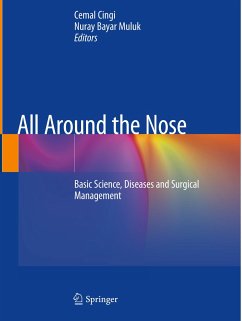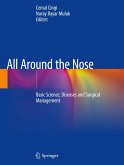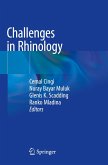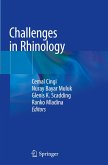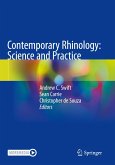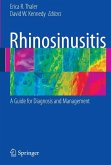All Around the Nose
Basic Science, Diseases and Surgical Management
Herausgegeben:Cingi, Cemal; Bayar Muluk, Nuray
All Around the Nose
Basic Science, Diseases and Surgical Management
Herausgegeben:Cingi, Cemal; Bayar Muluk, Nuray
- Broschiertes Buch
- Merkliste
- Auf die Merkliste
- Bewerten Bewerten
- Teilen
- Produkt teilen
- Produkterinnerung
- Produkterinnerung
This book is designed to provide all the information required for a sound understanding of diseases of the nose and paranasal sinuses and the surgical techniques used in their management. After an opening section on basic science, clinical and radiological assessment is explained and individual chapters focus on conditions ranging from infectious diseases, allergic rhinitis, and nasal polyposis to trauma, malignancies, and skin diseases. A wide variety of surgical techniques are then described with the aid of high-quality illustrations, covering nasal airway procedures and surgical approaches…mehr
Andere Kunden interessierten sich auch für
![All Around the Nose All Around the Nose]() All Around the Nose158,99 €
All Around the Nose158,99 €![Current Rhinology Current Rhinology]() Current Rhinology113,99 €
Current Rhinology113,99 €![Challenges in Rhinology Challenges in Rhinology]() Challenges in Rhinology110,99 €
Challenges in Rhinology110,99 €![Challenges in Rhinology Challenges in Rhinology]() Challenges in Rhinology150,99 €
Challenges in Rhinology150,99 €![Contemporary Rhinology: Science and Practice Contemporary Rhinology: Science and Practice]() Contemporary Rhinology: Science and Practice110,99 €
Contemporary Rhinology: Science and Practice110,99 €![Contemporary Rhinology: Science and Practice Contemporary Rhinology: Science and Practice]() Contemporary Rhinology: Science and Practice79,99 €
Contemporary Rhinology: Science and Practice79,99 €![Rhinosinusitis Rhinosinusitis]() Erica R. Thaler / David W. Kennedy (eds.)Rhinosinusitis87,99 €
Erica R. Thaler / David W. Kennedy (eds.)Rhinosinusitis87,99 €-
-
-
This book is designed to provide all the information required for a sound understanding of diseases of the nose and paranasal sinuses and the surgical techniques used in their management. After an opening section on basic science, clinical and radiological assessment is explained and individual chapters focus on conditions ranging from infectious diseases, allergic rhinitis, and nasal polyposis to trauma, malignancies, and skin diseases. A wide variety of surgical techniques are then described with the aid of high-quality illustrations, covering nasal airway procedures and surgical approaches to the paranasal sinuses, including diverse endoscopic and image-guided procedures, nasal reconstruction, and endonasal and external rhinoplasty. The book is a collaborative project between the new generation of Turkish specialists and well-known experts from across the world. It will be of value for ENT doctors in all countries, as well as for students and trainees and those working in ENT-related fields such as maxillo-facial surgery, pediatrics, allergology, neurology, infectious diseases, and neurosurgery.
Produktdetails
- Produktdetails
- Verlag: Springer / Springer International Publishing / Springer, Berlin
- Artikelnr. des Verlages: 978-3-030-21219-3
- 1st edition 2020
- Seitenzahl: 964
- Erscheinungstermin: 19. November 2020
- Englisch
- Abmessung: 279mm x 210mm x 48mm
- Gewicht: 2610g
- ISBN-13: 9783030212193
- ISBN-10: 303021219X
- Artikelnr.: 60433397
- Herstellerkennzeichnung Die Herstellerinformationen sind derzeit nicht verfügbar.
- Verlag: Springer / Springer International Publishing / Springer, Berlin
- Artikelnr. des Verlages: 978-3-030-21219-3
- 1st edition 2020
- Seitenzahl: 964
- Erscheinungstermin: 19. November 2020
- Englisch
- Abmessung: 279mm x 210mm x 48mm
- Gewicht: 2610g
- ISBN-13: 9783030212193
- ISBN-10: 303021219X
- Artikelnr.: 60433397
- Herstellerkennzeichnung Die Herstellerinformationen sind derzeit nicht verfügbar.
Cemal Cingi, MD is a Professor at the Otorhinolaryngology Department at Eskisehir Osmangazi University, Medical Faculty, Eskisehir, Turkey. He graduated from the School of Medicine, Istanbul University in 1984 and then entered the Otorhinolaryngology Residency Programme at Anadolu University, Eskisehir, becoming a Specialist in ORL & HNS in 1990. He was appointed as Associate Professor in 1995 and as Full Professor in 2000. In 2013 he became an accredited Specialist in Mouth, Face, and Chin Surgery. Dr. Cingi was the Chair of the ENT Section of the European Academy of Allergy and Clinical Immunology (EAACI) and President of the Asian Facial Plastic Surgery Society (AFPSS). He published more than 250 papers. He is editor-in-chief of Journal of ENT Updates and serves on the editorial board of several other journals. Dr. Cingi is the author or editor of eight already published books. Nuray Bayar Muluk, MD is a Professor at the Otorhinolaryngology Department at Kirikkale University, Medical Faculty in Turkey. She graduated from the Hacettepe University, Faculty of Medicine in 1990 and completed her ENT residency there in 1994. She became Assistant Professor in 1997, Associate Professor in 2003 and Full Professor in 2008 at the K¿r¿kkale University Faculty of Medicine, ENT Department. Her interests focused on basic research and rhinology and allergy. She published 190 articles in international publications, 70 in national publications, an international book, a national book, and contributed to several other books both international and national. She has 450 citations in international journals covered by Web of Science.
Chapter 1: Introduction.- PART I: BASIC SCIENCE OF NOSE & PARANASAL SINUSES Chapter 2: History of Rhinology.- Chapter 3: Histology and Embryology of the Nose and Paranasal Sinuses.- Chapter 4: Surgical Anatomy of the External and Internal Nose.- Chapter 5: Surgical Anatomy of the Paranasal Sinuses.- Chapter 6: Physiology of the Nose and Paranasal Sinuses.- Chapter 7: Mucociliary Clearance and Its Importance.- Chapter 8: Olfactory Function.- Chapter 9: Application of Computational Fluid Dynamics Methods to Understand Nasal Cavity Flows.- Chapter 10: The Evaluation of the Nose and Nasal Cavity and Airway.- Chapter 11: Clinical Assessment of Nasal Airway Obstruction.- PART II: ASSESSMENT OF NOSE AND PARANASAL SINUSES Chapter 12: Clinical Assessment of Mucociliary Disorders.- Chapter 13: Clinical Assessment of Olfactory Disorders.- Chapter 14: Acoustic Rhinometry.- Chapter 15: Principles of Allergy Skin Testing.- Chapter 16: Nasal Provocation Tests.- Chapter 17: Radiological Assessment of Nose and Paranasal Sinuses.- Chapter 18: Imaging of Nasal Cavity and Paranasal Sinus Tumors.- PART III DISEASES OF THE NOSE AND PARANASAL SINUSES Chapter 19: Congenital Malformations of the Nose and Paranasal Sinuses.- Chapter 20: Superantigens and Biofilms in Sinus Diseases.- Chapter 21: Infantile Rhinitis.- Chapter 22: Microbiology of Rhinosinusitis and Antimicrobial Resistance.- Chapter 23: Acute Viral Rhinitis.- Chapter 24: Acute Bacterial Rhinosinusitis: Pediatric and Adult.- Chapter 25: Chronic Rhinosinusitis: Pediatric and Adult.- Chapter 26: Complications of Rhinosinusitis.- Chapter 27: Acute Invasive Fungal Rhinosinusitis.- Chapter 28: Allergic Fungal Rhinosinusitis.- Chapter 29: Sinusitis and Chronic Progressive Exercise-induced Cough and Dyspnea.- Chapter 30: Role of Anosmia on Personal Communication.- Chapter 31: Quality of Life in Rhinosinusitis.- PART IV: ALLERGIC AND NON-ALLERGIC RHINITIS Chapter 32: Pathophysiology of Allergic Rhinitis.- Chapter 33: Epidemiology of Allergic Rhinitis.- Chapter 34: Hypersensitivity to Aspirin and Other Non-Steroidal Anti-Inflammatory Drugs.- Chapter 35: Medical Treatment of Allergic Rhinitis.- Chapter 36: Immunotherapy for Allergic Rhinitis.- Chapter 37: Herbal Remedy Alternatives for Allergic Rhinitis.- Chapter 38: Allergic Rhinitis in Pediatric Patients.- Chapter 39: Role of Allergic Rhinitis on Personal Communication.- Chapter 40: Local Allergic Rhinitis.- Chapter 41: Nonallergic Rhinitis.- PART V: NASAL POLYPOSIS Chapter 42: Epidemiology of Nasal Polyposis.- Chapter 43: Pathophysiology of Chronic Rhinosinusitis with Nasal Polyps.- Chapter 44: Medical Treatment of Nasal Polyposis.- Chapter 45: Surgical Treatment of Nasal Polyposis.- Chapter 46: Evidence-based Treatment of Nasal Polyposis.- PART VI: SURGERY OF NASAL CAVITY AND AIRWAY Chapter 47: Paranasal Sinus Mucoceles.- Chapter 48: Management of Epistaxis.- Chapter 49: Rheumatological Diseases of the Nose and Paranasal Sinuses.- Chapter 50: Surgical Management of the Nasal Septum.- Chapter 51: Nasal Valve Surgery.- Chapter 52: Surgical Management of Septal Perforation.- Chapter 53: Surgical Management of the Turbinates.- Chapter 54: Odontogenic Casuese of Sinus Infections and Treatment.- Chapter 55: Management of Trauma to the Nose and Paranasal Sinuses.- Chapter 56: Pediatric Septoplasty.- Chapter 57: Surgical Management of Choanal Atresia.- Chapter 58: Tumors and Malignancies of Nasal Cavity.- Chapter 59: Robot Assisted Surgery Around the Nose.- PART VII: SURGICAL MANAGEMENT OF PARANASAL SINUSES Chapter 60: Minimally Invasive Endoscopic Sinus Surgery.- Chapter 61: Functional Endoscopic Sphenoethmoidectomy.- Chapter 62: Frontal Sinus Surgery.- Chapter 63: Complications of Endoscopic Sinus Surgery.- Chapter 64: Revision Sinus Surgery.- Chapter 65: Dacryocystorhinostomy.- Chapter 66: Laser Dacryocystorhinostomy.- Chapter 67: Functional Endoscopic Dilatation of the Paranasal Sinuses.- Chapter 68: Endoscopic Sinus Surgery in Pediatric Patients.- Chapter 69: External Approaches for Sinus Surgery.- Chapter 70: Combined Open and Endoscopic Approaches to the Paranasal Sinus.- Chapter 71: Endoscopic Management of Malignant Sinonasal Tumors.- Chapter 72: Endoscopic Optic Nerve Decompression.- Chapter 73: Endoscopic Management of Cerebrospinal Fluid Leaks and Encephaloceles.- Chapter 74: Endoscopic Transsphenoidal Hypophysectomy.- Chapter 75: Endoscopic Skull Base Surgery - Anatomical Basis of Skull Base Approaches.- Chapter 76: Conventional and Powered Instrumentation for Endoscopic Sinus Surgery.- Chapter 77: Conventional and Powered Instrumentation for Endoscopic Skull Base Surgery.- Chapter 78: Image-guided Sinus Surgery.- Chapter 79: 3D Modeling Before Sinus Surgery.- Chapter 80: Robotic Surgery of Skull Base.- PART VIII: NASAL RECONSTRUCTION Chapter 81: Management of Small Nasal Defects.- Chapter 82: Grafting in Nasal Reconstruction.- Chapter 83: Local Nasal Flaps.- Chapter 84: Regional Nasal Flaps: Forehead Flaps.- Chapter 85: Inner Lining Reconstruction of the Nose. - Chapter 86: Management of Full-thickness Nasal Defects.- Chapter 87: Regenerative Medicine in Rhinology.- Chapter 88: Orthodontic Abnormalities of Upper Jaw as a Cause of Maxillary Sinus Problems.- PART IX: RHINOPLASTY Chapter 89: Preoperative Facial Analysis.- Chapter 90: Anesthesia for Rhinoplasty.- Chapter 91: Endonasal and External Approaches in Rhinoplasty.- Chapter 92: Basic Techniques for Endonasal Rhinoplasty.- Chapter 93: Basic Techniques for External Rhinoplasty.- Chapter 94: Osteotomies.- Chapter 95: Management of the Midvault.- Chapter 96: Management of the Deviated Septum.- Chapter 97: Nasal Tip Surgery.- Chapter 98: Alar Base Surgery.- Chapter 99: Reconstruction of Saddle Nose Deformity.- Chapter 100: Complications of Rhinoplasty.- Chapter 101: Revision Rhinoplasty.- Chapter 102: Rib Grafting in Rhinoplasty.- Chapter 103: Allografts in Rhinoplasty.- Chapter 104: Application ofFillers in Nonsurgical Rhinoplasty.- Chapter 105: Communication Disorders due to Facial Deformities.
Chapter 1: Introduction.- PART I: BASIC SCIENCE OF NOSE & PARANASAL SINUSES Chapter 2: History of Rhinology.- Chapter 3: Histology and Embryology of the Nose and Paranasal Sinuses.- Chapter 4: Surgical Anatomy of the External and Internal Nose.- Chapter 5: Surgical Anatomy of the Paranasal Sinuses.- Chapter 6: Physiology of the Nose and Paranasal Sinuses.- Chapter 7: Mucociliary Clearance and Its Importance.- Chapter 8: Olfactory Function.- Chapter 9: Application of Computational Fluid Dynamics Methods to Understand Nasal Cavity Flows.- Chapter 10: The Evaluation of the Nose and Nasal Cavity and Airway.- Chapter 11: Clinical Assessment of Nasal Airway Obstruction.- PART II: ASSESSMENT OF NOSE AND PARANASAL SINUSES Chapter 12: Clinical Assessment of Mucociliary Disorders.- Chapter 13: Clinical Assessment of Olfactory Disorders.- Chapter 14: Acoustic Rhinometry.- Chapter 15: Principles of Allergy Skin Testing.- Chapter 16: Nasal Provocation Tests.- Chapter 17: Radiological Assessment of Nose and Paranasal Sinuses.- Chapter 18: Imaging of Nasal Cavity and Paranasal Sinus Tumors.- PART III DISEASES OF THE NOSE AND PARANASAL SINUSES Chapter 19: Congenital Malformations of the Nose and Paranasal Sinuses.- Chapter 20: Superantigens and Biofilms in Sinus Diseases.- Chapter 21: Infantile Rhinitis.- Chapter 22: Microbiology of Rhinosinusitis and Antimicrobial Resistance.- Chapter 23: Acute Viral Rhinitis.- Chapter 24: Acute Bacterial Rhinosinusitis: Pediatric and Adult.- Chapter 25: Chronic Rhinosinusitis: Pediatric and Adult.- Chapter 26: Complications of Rhinosinusitis.- Chapter 27: Acute Invasive Fungal Rhinosinusitis.- Chapter 28: Allergic Fungal Rhinosinusitis.- Chapter 29: Sinusitis and Chronic Progressive Exercise-induced Cough and Dyspnea.- Chapter 30: Role of Anosmia on Personal Communication.- Chapter 31: Quality of Life in Rhinosinusitis.- PART IV: ALLERGIC AND NON-ALLERGIC RHINITIS Chapter 32: Pathophysiology of Allergic Rhinitis.- Chapter 33: Epidemiology of Allergic Rhinitis.- Chapter 34: Hypersensitivity to Aspirin and Other Non-Steroidal Anti-Inflammatory Drugs.- Chapter 35: Medical Treatment of Allergic Rhinitis.- Chapter 36: Immunotherapy for Allergic Rhinitis.- Chapter 37: Herbal Remedy Alternatives for Allergic Rhinitis.- Chapter 38: Allergic Rhinitis in Pediatric Patients.- Chapter 39: Role of Allergic Rhinitis on Personal Communication.- Chapter 40: Local Allergic Rhinitis.- Chapter 41: Nonallergic Rhinitis.- PART V: NASAL POLYPOSIS Chapter 42: Epidemiology of Nasal Polyposis.- Chapter 43: Pathophysiology of Chronic Rhinosinusitis with Nasal Polyps.- Chapter 44: Medical Treatment of Nasal Polyposis.- Chapter 45: Surgical Treatment of Nasal Polyposis.- Chapter 46: Evidence-based Treatment of Nasal Polyposis.- PART VI: SURGERY OF NASAL CAVITY AND AIRWAY Chapter 47: Paranasal Sinus Mucoceles.- Chapter 48: Management of Epistaxis.- Chapter 49: Rheumatological Diseases of the Nose and Paranasal Sinuses.- Chapter 50: Surgical Management of the Nasal Septum.- Chapter 51: Nasal Valve Surgery.- Chapter 52: Surgical Management of Septal Perforation.- Chapter 53: Surgical Management of the Turbinates.- Chapter 54: Odontogenic Casuese of Sinus Infections and Treatment.- Chapter 55: Management of Trauma to the Nose and Paranasal Sinuses.- Chapter 56: Pediatric Septoplasty.- Chapter 57: Surgical Management of Choanal Atresia.- Chapter 58: Tumors and Malignancies of Nasal Cavity.- Chapter 59: Robot Assisted Surgery Around the Nose.- PART VII: SURGICAL MANAGEMENT OF PARANASAL SINUSES Chapter 60: Minimally Invasive Endoscopic Sinus Surgery.- Chapter 61: Functional Endoscopic Sphenoethmoidectomy.- Chapter 62: Frontal Sinus Surgery.- Chapter 63: Complications of Endoscopic Sinus Surgery.- Chapter 64: Revision Sinus Surgery.- Chapter 65: Dacryocystorhinostomy.- Chapter 66: Laser Dacryocystorhinostomy.- Chapter 67: Functional Endoscopic Dilatation of the Paranasal Sinuses.- Chapter 68: Endoscopic Sinus Surgery in Pediatric Patients.- Chapter 69: External Approaches for Sinus Surgery.- Chapter 70: Combined Open and Endoscopic Approaches to the Paranasal Sinus.- Chapter 71: Endoscopic Management of Malignant Sinonasal Tumors.- Chapter 72: Endoscopic Optic Nerve Decompression.- Chapter 73: Endoscopic Management of Cerebrospinal Fluid Leaks and Encephaloceles.- Chapter 74: Endoscopic Transsphenoidal Hypophysectomy.- Chapter 75: Endoscopic Skull Base Surgery - Anatomical Basis of Skull Base Approaches.- Chapter 76: Conventional and Powered Instrumentation for Endoscopic Sinus Surgery.- Chapter 77: Conventional and Powered Instrumentation for Endoscopic Skull Base Surgery.- Chapter 78: Image-guided Sinus Surgery.- Chapter 79: 3D Modeling Before Sinus Surgery.- Chapter 80: Robotic Surgery of Skull Base.- PART VIII: NASAL RECONSTRUCTION Chapter 81: Management of Small Nasal Defects.- Chapter 82: Grafting in Nasal Reconstruction.- Chapter 83: Local Nasal Flaps.- Chapter 84: Regional Nasal Flaps: Forehead Flaps.- Chapter 85: Inner Lining Reconstruction of the Nose. - Chapter 86: Management of Full-thickness Nasal Defects.- Chapter 87: Regenerative Medicine in Rhinology.- Chapter 88: Orthodontic Abnormalities of Upper Jaw as a Cause of Maxillary Sinus Problems.- PART IX: RHINOPLASTY Chapter 89: Preoperative Facial Analysis.- Chapter 90: Anesthesia for Rhinoplasty.- Chapter 91: Endonasal and External Approaches in Rhinoplasty.- Chapter 92: Basic Techniques for Endonasal Rhinoplasty.- Chapter 93: Basic Techniques for External Rhinoplasty.- Chapter 94: Osteotomies.- Chapter 95: Management of the Midvault.- Chapter 96: Management of the Deviated Septum.- Chapter 97: Nasal Tip Surgery.- Chapter 98: Alar Base Surgery.- Chapter 99: Reconstruction of Saddle Nose Deformity.- Chapter 100: Complications of Rhinoplasty.- Chapter 101: Revision Rhinoplasty.- Chapter 102: Rib Grafting in Rhinoplasty.- Chapter 103: Allografts in Rhinoplasty.- Chapter 104: Application ofFillers in Nonsurgical Rhinoplasty.- Chapter 105: Communication Disorders due to Facial Deformities.

